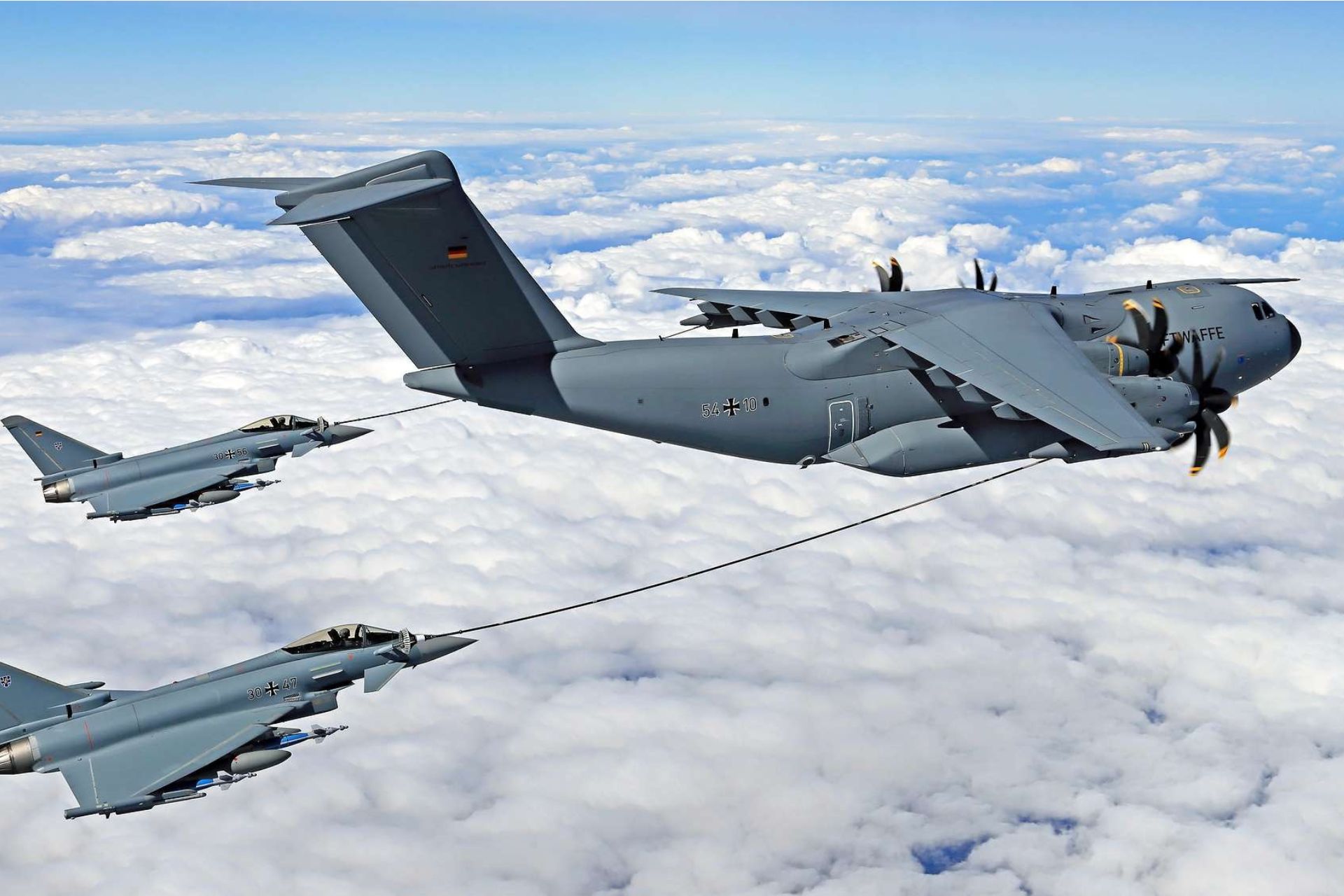Poland’s Interest in Airbus A400M Revives Export Prospects for European Transport Aircraft

{loadposition bannertop}
{loadposition sidebarpub}
According to information published by the specialized site Hartpunkt on January 24, 2025, Poland has expressed interest in acquiring the Airbus A400M military transport aircraft. This development comes amid the challenges faced by the European program, which was launched more than fifteen years ago to modernize the airlift capabilities of its partner nations’ armed forces. Facing financial and industrial difficulties, the A400M program may find a significant opportunity through a potential Polish order, offering renewed export prospects for this strategic aircraft.
Follow Army Recognition on Google News at this link
An A400M AAR refuels two Eurofighter of 73 Tactical Air Force Wing equipped with Guided Bomb Unit (Picture source: Bundeswehr)
In 2010, the A400M program, already encountering significant challenges, was saved through an agreement between Airbus and its seven main client nations: France, the United Kingdom, Germany, Spain, Belgium, Luxembourg, and Turkey. These nations provided an additional €3.5 billion in funding, partly in the form of repayable advances contingent upon future exports. At the time, Airbus had high ambitions, aiming to sell between 400 and 500 A400M aircraft. However, fifteen years later, the results are modest, with only two export contracts secured: two aircraft for Kazakhstan and another two for Indonesia, which also holds an option for four more units.
National decisions to reduce orders have further impacted production outlooks. In both Spain and France, initial commitments have been scaled back. According to France’s 2024-2035 military programming law, the French Air and Space Force is now expected to receive 35 aircraft by 2035, well below the originally planned 50 units. Despite this, French Defense Minister Sébastien Lecornu has reaffirmed the strategic importance of the A400M for French forces, while emphasizing the need to secure new export contracts to ensure the program’s economic viability and maintain the production chain.
The Airbus A400M is a versatile military transport aircraft designed by Airbus Military to meet the tactical and strategic needs of modern armed forces. Equipped with four Europrop TP400-D6 turboprop engines, it can carry up to 32 tons of equipment, heavy machinery, or armored vehicles over distances of 2,300 nautical miles at a maximum speed of 780 km/h. Its adaptable cargo bay can accommodate up to 108 paratroopers, helicopters, or a mix of troops and cargo, while its onboard systems enable autonomous operations, even on short or rough airstrips. The aircraft can also undertake missions such as medical evacuation, aerial refueling, and transport in crisis zones.
The A400M incorporates advanced technologies, including a night-vision-compatible glass cockpit, fly-by-wire controls, and modern defensive aids such as radar and infrared detectors, electronic countermeasures, and flare dispensers. Its robust and innovative design, including composite wings and woven-fiber propellers, makes it more efficient and reliable than its predecessors. Capable of operating at low altitudes or up to 11,300 meters, it offers flexibility, performance, and reduced operating costs, meeting the demands of both military and humanitarian missions.
Despite these recognized capabilities, the A400M has struggled to attract new clients in Europe, where countries like the Netherlands and Sweden have opted for Embraer’s C-390 Millennium to modernize their aging C-130 Hercules fleets. In this context, Poland presents a significant opportunity for Airbus. The country, seeking to replace its second-hand C-130E/H aircraft acquired from the United States, has been identified by German Defense Minister Boris Pistorius as a potential client. During a visit to Airbus’s Bremen facility, which produces the A400M’s fuselage, Pistorius confirmed a “very specific interest” from Poland and noted that discussions are ongoing. Reports suggest that the Polish Air Force could consider acquiring ten aircraft.
However, the A400M program faces substantial challenges. German labor unions warn that production could cease as early as 2027 or 2028 if no strategic decisions are made. This outlook raises concerns, particularly for workers at the Bremen facility, a key site in the aircraft’s manufacturing process. Following Pistorius’s visit, A400M program director Gerd Weber emphasized the critical situation. While Germany, as the largest operator with 53 aircraft, has met its contractual obligations, export orders remain insufficient to offset reduced purchases from historical clients such as Spain and France.
This situation has also highlighted tensions over the distribution of production value. According to observers cited by Hartpunkt, it is problematic that France and Spain retain equivalent shares in production despite their reduced orders, as this contradicts the usual European practice of proportional value distribution in defense projects. In response, German unions have proposed relocating the A400M’s final assembly line from Seville to Bremen, adding to the existing challenges among European partners.
Amid this uncertain environment, Airbus and its partner nations are intensifying efforts to promote the A400M internationally. German Defense Minister Pistorius has reaffirmed his government’s commitment to supporting the export of this strategic aircraft, while negotiations with Poland offer a potential lifeline for the program. Nonetheless, the A400M’s future depends on swift decisions and strengthened cooperation among stakeholders to overcome the economic and industrial challenges threatening its continuity.
Poland’s interest in the A400M represents a significant opportunity for Airbus in the context of declining orders and uncertainties about production sustainability. However, the situation remains critical, requiring urgent action to safeguard this emblem of European aeronautical industry—one that embodies shared technological ambitions yet faces the realities of global markets and shifting national priorities.

{loadposition bannertop}
{loadposition sidebarpub}
According to information published by the specialized site Hartpunkt on January 24, 2025, Poland has expressed interest in acquiring the Airbus A400M military transport aircraft. This development comes amid the challenges faced by the European program, which was launched more than fifteen years ago to modernize the airlift capabilities of its partner nations’ armed forces. Facing financial and industrial difficulties, the A400M program may find a significant opportunity through a potential Polish order, offering renewed export prospects for this strategic aircraft.
An A400M AAR refuels two Eurofighter of 73 Tactical Air Force Wing equipped with Guided Bomb Unit (Picture source: Bundeswehr)
In 2010, the A400M program, already encountering significant challenges, was saved through an agreement between Airbus and its seven main client nations: France, the United Kingdom, Germany, Spain, Belgium, Luxembourg, and Turkey. These nations provided an additional €3.5 billion in funding, partly in the form of repayable advances contingent upon future exports. At the time, Airbus had high ambitions, aiming to sell between 400 and 500 A400M aircraft. However, fifteen years later, the results are modest, with only two export contracts secured: two aircraft for Kazakhstan and another two for Indonesia, which also holds an option for four more units.
National decisions to reduce orders have further impacted production outlooks. In both Spain and France, initial commitments have been scaled back. According to France’s 2024-2035 military programming law, the French Air and Space Force is now expected to receive 35 aircraft by 2035, well below the originally planned 50 units. Despite this, French Defense Minister Sébastien Lecornu has reaffirmed the strategic importance of the A400M for French forces, while emphasizing the need to secure new export contracts to ensure the program’s economic viability and maintain the production chain.
The Airbus A400M is a versatile military transport aircraft designed by Airbus Military to meet the tactical and strategic needs of modern armed forces. Equipped with four Europrop TP400-D6 turboprop engines, it can carry up to 32 tons of equipment, heavy machinery, or armored vehicles over distances of 2,300 nautical miles at a maximum speed of 780 km/h. Its adaptable cargo bay can accommodate up to 108 paratroopers, helicopters, or a mix of troops and cargo, while its onboard systems enable autonomous operations, even on short or rough airstrips. The aircraft can also undertake missions such as medical evacuation, aerial refueling, and transport in crisis zones.
The A400M incorporates advanced technologies, including a night-vision-compatible glass cockpit, fly-by-wire controls, and modern defensive aids such as radar and infrared detectors, electronic countermeasures, and flare dispensers. Its robust and innovative design, including composite wings and woven-fiber propellers, makes it more efficient and reliable than its predecessors. Capable of operating at low altitudes or up to 11,300 meters, it offers flexibility, performance, and reduced operating costs, meeting the demands of both military and humanitarian missions.
Despite these recognized capabilities, the A400M has struggled to attract new clients in Europe, where countries like the Netherlands and Sweden have opted for Embraer’s C-390 Millennium to modernize their aging C-130 Hercules fleets. In this context, Poland presents a significant opportunity for Airbus. The country, seeking to replace its second-hand C-130E/H aircraft acquired from the United States, has been identified by German Defense Minister Boris Pistorius as a potential client. During a visit to Airbus’s Bremen facility, which produces the A400M’s fuselage, Pistorius confirmed a “very specific interest” from Poland and noted that discussions are ongoing. Reports suggest that the Polish Air Force could consider acquiring ten aircraft.
However, the A400M program faces substantial challenges. German labor unions warn that production could cease as early as 2027 or 2028 if no strategic decisions are made. This outlook raises concerns, particularly for workers at the Bremen facility, a key site in the aircraft’s manufacturing process. Following Pistorius’s visit, A400M program director Gerd Weber emphasized the critical situation. While Germany, as the largest operator with 53 aircraft, has met its contractual obligations, export orders remain insufficient to offset reduced purchases from historical clients such as Spain and France.
This situation has also highlighted tensions over the distribution of production value. According to observers cited by Hartpunkt, it is problematic that France and Spain retain equivalent shares in production despite their reduced orders, as this contradicts the usual European practice of proportional value distribution in defense projects. In response, German unions have proposed relocating the A400M’s final assembly line from Seville to Bremen, adding to the existing challenges among European partners.
Amid this uncertain environment, Airbus and its partner nations are intensifying efforts to promote the A400M internationally. German Defense Minister Pistorius has reaffirmed his government’s commitment to supporting the export of this strategic aircraft, while negotiations with Poland offer a potential lifeline for the program. Nonetheless, the A400M’s future depends on swift decisions and strengthened cooperation among stakeholders to overcome the economic and industrial challenges threatening its continuity.
Poland’s interest in the A400M represents a significant opportunity for Airbus in the context of declining orders and uncertainties about production sustainability. However, the situation remains critical, requiring urgent action to safeguard this emblem of European aeronautical industry—one that embodies shared technological ambitions yet faces the realities of global markets and shifting national priorities.





